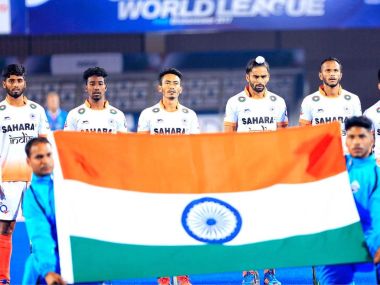Even though defending is a thankless job, yet it requires a certain art, a level of detachment that comes from the knowledge that applause is only for the ‘aura ringed forwards’. But when defenders go into a slump or face a dip in form or have inconsistent pitch behaviour, and teams like England take advantage, it reduces India to clichéd excuses for what was one of the worst performances of this year. England may have won 3-2, the match-winning goal snatched straight out of India’s hands, but the truth is the hosts played like they were suffering jet lag. At the outset, to be fair, it’s a failure in only their second match at the Hockey World League Final; but a collapse of mammoth proportions. Except for the initial periods of the 1st quarter and the start of the 4th quarter, India self-destructed. Previously this year at the Azlan Shah against Malaysia and then in the HWL Semi-Finals in London, India played much below par against Canada and then Malaysia to lose a semi-final spot. The team then blew away circle penetrations that crossed 15 with strikes on goals pegged at 16 and 20. [caption id=“attachment_4239633” align=“alignnone” width=“825”] The Indian hockey team before a Hockey World League Final match. Image courtesy: Twitter/@TheHockeyIndia[/caption] But at the Kalinga Stadium in front of a packed house, India didn’t play hockey. They let England enjoy domination, allowed the English to play themselves into the game and sat back, their own play riddled with basic errors to lose a match that, purely based on their form and skill, should have been in their pocket. In the first quarter, around the 5th minute, there was a moment when Varun had the ball and he tried dribbling past two English forwards and failed. India were playing in 2017 but the mindset was back to the eighties. Gone was the first touch release. And its place was taken by selfishness, and a move away from the game plan. The surprising aspect is that it’s not a team that has just graduated from the junior league to the senior. Harmanpreet Singh and Rupinder Pal Singh were at the Rio Olympics. Besides, Harmanpreet was part of the junior squad which won the 2016 Junior World Cup. The captain, Manpreet Singh, played his 200th international in the 1-1 draw against Australia and in just 24 hours forgot the discipline instilled over 200 games. Chinglensana Singh, SK Uthappa, SV Sunil, Akashdeep Singh, Mandeep Singh, Gurjant Singh all blew it away in a refusal to accept they were not in the right frame of mind. Instead of holding the ball and controlling the proceedings, which was of vital importance, they went for wild passes more in hope than anything else. Birendra Lakra, coming back after a long lay-off, showed he still needs more time. But what was baffling was Rupinder. He did score the equaliser which brought the house down. But his field play was that of an amateur; of a player who was not willing to grind it the way the English did it in the 1st quarter. England were reinforced by the return of Brendan Creed and Harry Martin but what was impressive was even though they were still way below their best, they played as a unit. Rotation won the day as they probed for weaknesses in the Indian side. To a good coach like Bobby Crutchley, it was evident that India wasn’t a unified team. The flow so evident against Australia was simply not there. Even in the forward line, Mandeep, Sunil, Akashdeep, Gurjant and Lalit Thapa played as individuals. Sunil seriously needs to balance his ball skills with that of his sprinting ability. With acres of space available but no support, Sunil sprinted and was deprived of the ball four times in the match. Baffling was the fact that each of those turnovers were fashioned into a counter-attack by the English. After 222 caps, you don’t need a Sjoerd Marijne to tell you that. Each of those runs could have been held back to build a move with the defence moving up and the midfield getting an opportunity to create something substantial. Glimpses of the level of a Nehru Cup hockey match were provided by some of the players. Criticism is harsh but players with 100 caps have a responsibility to not only the team but to the 8,000-odd paying fans who turned up to watch the team play your best and not put in a shoddy performance. It’s a huge credit to the fans that they stayed put even after England had a 2-0 lead in the 43rd minute, enjoyed the comeback and then applauded the home team after the match. Marijne, at the post match conference, looked thunderous. “Players don’t do it with purpose but that cost us the game,” Marijne said when asked about India’s costly defensive lapses. “But it was not only about defence. The speed of the game in the beginning was not good enough. We held the ball too long and we lost the ball too much. The pressing was not like yesterday. I have already told them before the tournament that we really need to work on our consistency. For me the big question is why we dropped from yesterday’s level. That’s what we need to talk about because if you have reasons you can improve,” he said. In a way, it wasn’t good enough an explanation. Of course, players don’t do it on purpose. Any explanation at this point of time does sound like a worn-out cliché, given the wealth of experience many of the players had — just counting those who have played more than 100 matches, India had the experience of 1,357 international matches.
India rarely demonstrated a tactical know-how to kill counter-attacks. Over the years, we have a weakness for the counter and the midfield or the forwards are the first line. Look back into the match against Australia and that’s where we got it right. India kept the Aussies boxed in and rarely let them create.
India’s midfield was in disarray and players were not willing to work hard. Uthappa drifted through the match while Mandeep rarely made an attempt to regain control in the middle of the pitch. In the 2nd and 3rd quarters, three-four Indian players usually boxed themselves into a space of five to ten metres. Short passes can easily be broken up and if you count the turn-overs when India had the ball, they were 12; that in itself created pressure. Not once did the back line show a structure and when Harmanpreet was deprived off a high ball by a trapping error, Sam Ward found space past Akash Chikte. There were no back-ups here. The bigger issues lay in the play-making. It’s in short supply and some players have a very narrow field of view. Thus it’s almost impossible to generate any kind of in-possession momentum. Most of the movement died simply because the player in sequence wasn’t able to keep the pass going. At the post-match conference, an almost different Indian captain faced the media. Along with the team, he too had had a bad day. “I think there were too many errors and we need to get back to the basics,” said a Manpreet, who was visibly shocked. “We need to create more penalty corners.” In two matches, India have had nine penalty corners and just one direct flick to show. Finding answers in penalty corners is easy. But field work is what leads to penalty corners. India did really well in the 4th quarter to bring back momentum and press an English side that was sitting on a 2-0 lead. India pulled back a goal in the 47th minute off their 3rd penalty corner. Rupinder’s flick bounced off George Pinner’s pads and Akashdeep rushing in didn’t hesitate to smash the ball into goal. The fans came back to life and England realised they now needed to work. And then off the 5th penalty corner, Rupinder’s low but powerful flick bisected the goalkeeper and the defender to bring back the fans on their feet. Ideally, India should have packed the midfield, and even tried bringing back Lalit, to hang onto the ball. But they refused to regroup; though the match-winner by Sam Ward in the 57th minute came off a late clearance by Manpreet. Ward found space and beat Chikte on his right side; it was a goal that should have been saved by the Indian goalkeeper. India would do well to hasten the release point of the ball because in delaying they are squandering away the fraction of a second that could make all the difference. India now have a rest day on Sunday, a day where introspection and a team talk could get them ready for Germany on Monday. Potential is a variable beast. India need to plug the gap between what it does and what it is seriously capable of.


)




